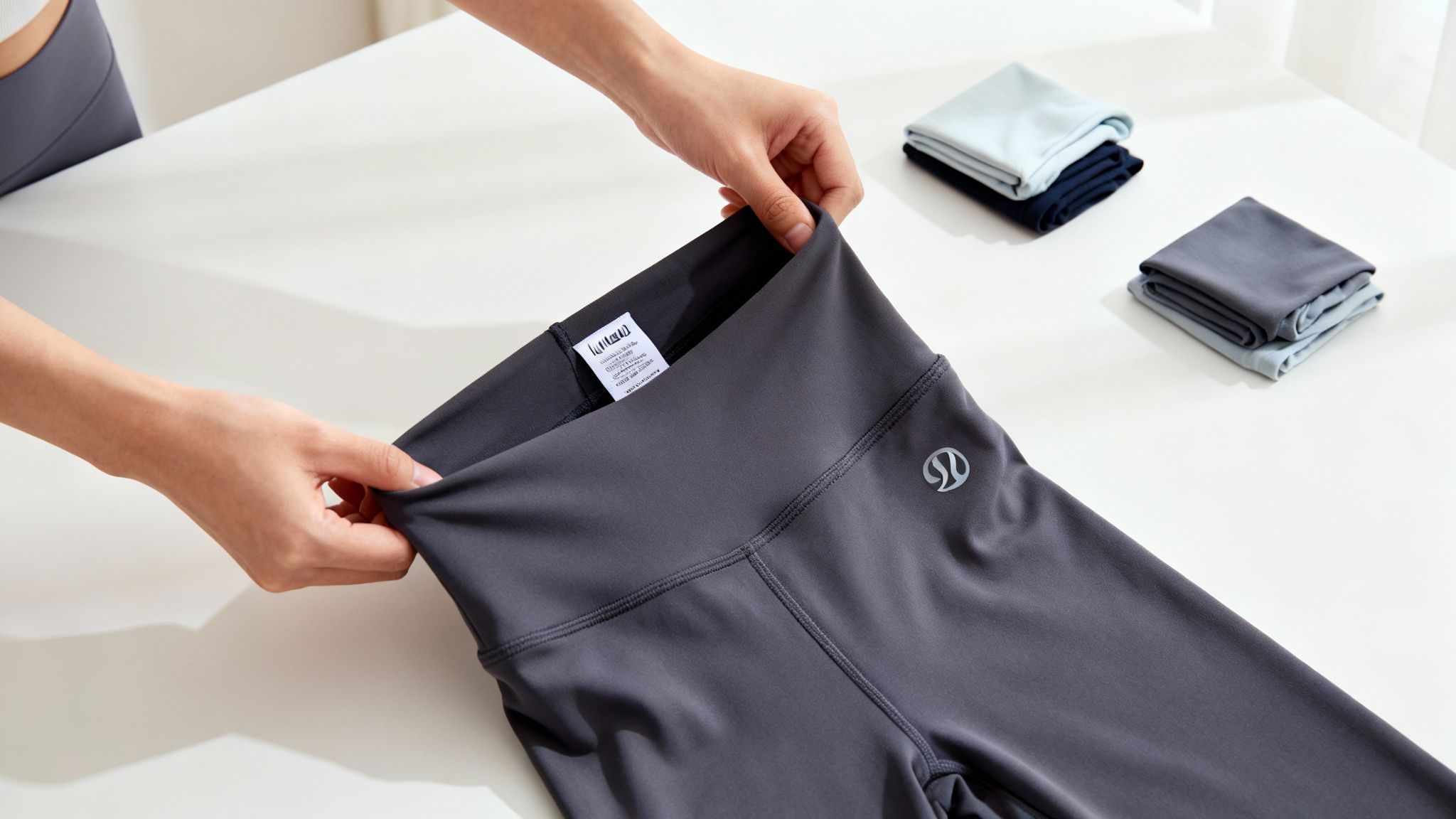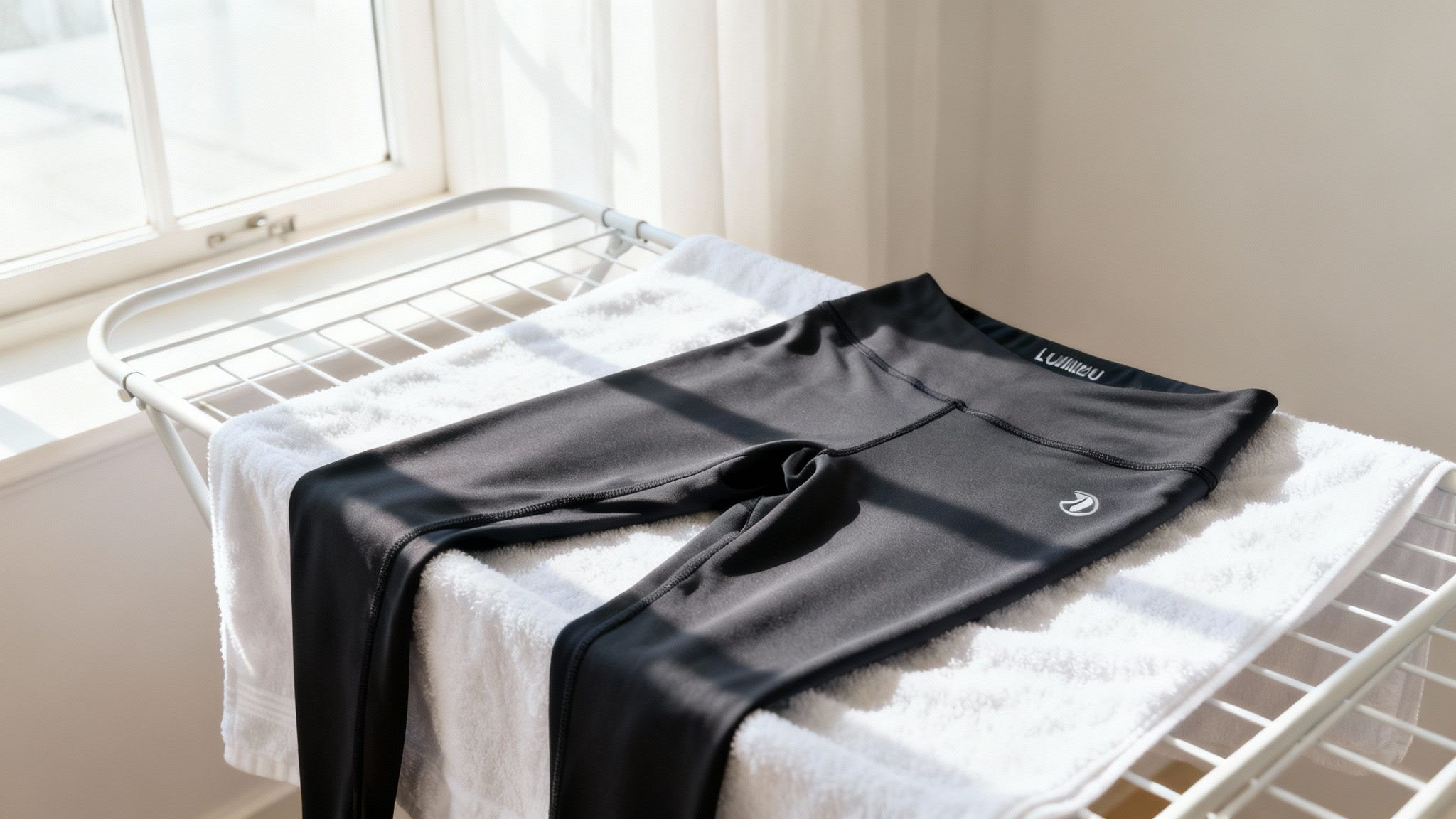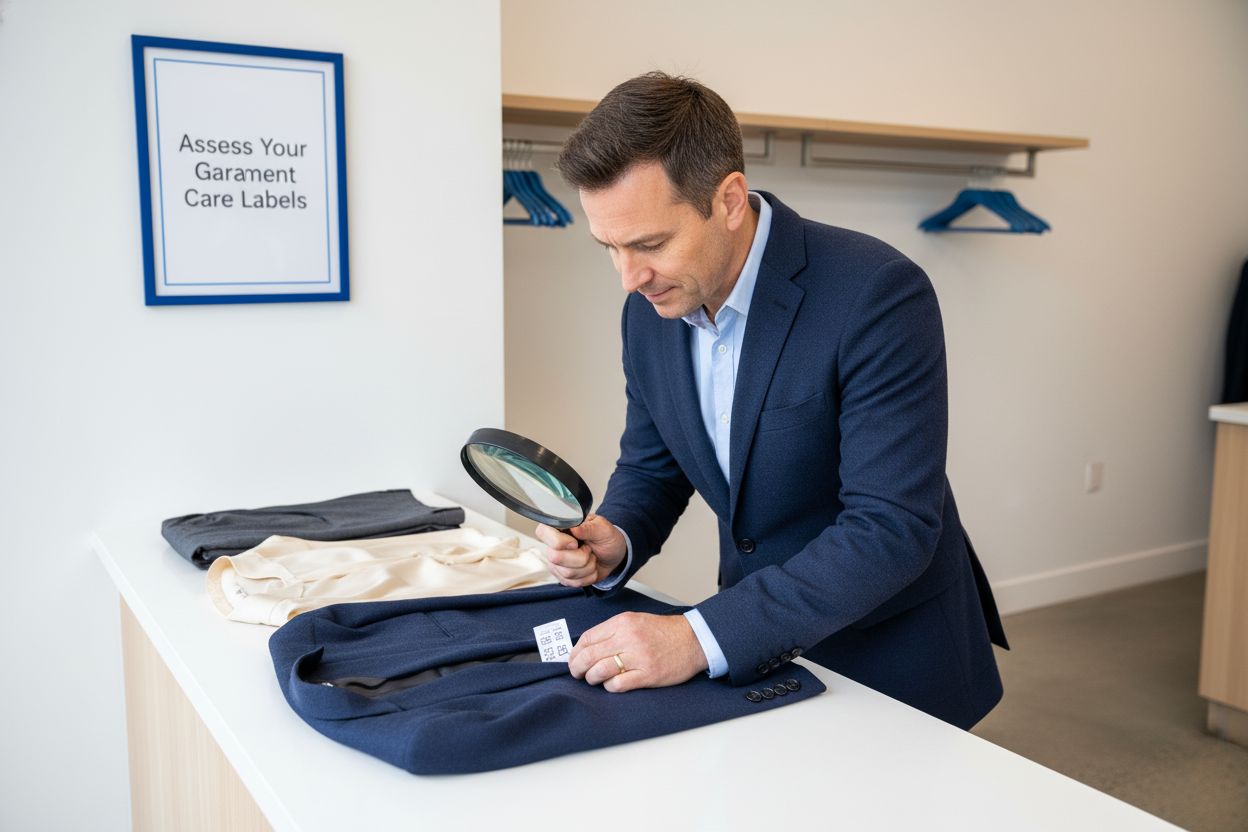How to Wash Lululemon to Keep Your Gear Like New

Before your gear even sees the inside of a washing machine, a few quick prep steps can make a world of difference in its lifespan and performance. Think of it as laying the groundwork for a perfect wash, every single time.
The Pre-Wash Ritual for Perfect Results

Protecting that Lululemon investment starts long before you press "start." Just a few minutes of prep work can be the difference between gear that lasts for years and pieces that prematurely pill, stretch out, or lose their color.
Always Check the Care Label First
This is the golden rule, and it's non-negotiable. Lululemon uses a whole range of high-tech fabrics, and each one has its own personality. For example, the buttery-soft Nulu™ fabric on your Align leggings needs a much gentler touch than the durable Everlux™ on your Wunder Train tights. The care tag is your roadmap, telling you exactly what that specific piece needs to stay in top shape.
Sort by Color and Fabric Type
Sorting isn't just a suggestion—it's your best defense against laundry mishaps. Tossing your bright pink Swiftly Tech top in with dark navy leggings is just asking for a color-bleeding disaster.
But it goes beyond just colors. Sorting by fabric texture is just as crucial.
- Group similar fabrics: Wash your Lululemon items with other smooth, synthetic activewear.
- Keep abrasive materials separate: Never, ever wash your gear with rough stuff like denim, towels, or anything with zippers. The friction from these materials is the number one cause of pilling on those delicate performance fabrics.
Pro Tip: Think of your Lululemon like a social club; it prefers to hang out with similar friends. Mixing it with a rough crowd like towels and jeans will only lead to trouble.
Turn Garments Inside Out
This two-second habit does two very important things. First, it protects the soft, smooth outer finish from getting roughed up, which helps stop pilling before it starts and keeps the colors looking new.
Second, it exposes the inside of the garment—the part that actually gets sweaty and oily—directly to the water and detergent. This means you get a much deeper, more hygienic clean right where it counts. You can dive deeper into this with our guide on how to care for modern textiles.
Setting Up Your Washing Machine For Success

Alright, now that your gear is sorted and prepped, it's time to dial in the right settings on your washing machine. This isn't just about getting things clean; it’s about actively protecting those high-performance fabrics that make your Lululemon so comfortable and effective. Getting this part right is my secret to keeping my favorite pieces looking and feeling brand new for years.
The single most important choice you can make is the water temperature. I can't stress this enough: always use a cold water setting. Hot water is the absolute enemy of fabrics containing Lycra® elastane, which is that magic ingredient giving you the signature four-way stretch. Heat literally degrades those sensitive fibers, causing them to lose their elasticity and shape over time.
Next up is the cycle selection. You'll want to opt for your machine's 'delicate' or 'gentle' cycle. These settings use a much slower spin speed and less aggressive agitation, which basically mimics a safer hand-washing environment. This simple choice minimizes stress on the seams and prevents the delicate fibers from getting stretched or mangled during the wash.
Pro-Level Protection With a Simple Tool
If you want to take your garment care to the next level, a mesh laundry bag is a non-negotiable tool in my laundry room. It’s an inexpensive accessory that provides an incredible amount of protection, especially for certain items.
- For Strappy Tops and Sports Bras: A bag is a lifesaver. It prevents those delicate straps from getting tangled, twisted, or stretched out by the machine's drum.
- For Items with Zippers or Clasps: It stops zippers on something like a Define Jacket from snagging and tearing the fabric of other clothes in the same load.
Using cold water has benefits that go way beyond just your clothes. Washing at temperatures around 20°C (68°F) can slash a machine's energy use by up to 50%. Most modern detergents are actually formulated to work best in cold water anyway. You can find more insights on energy-saving laundry habits on rinse.com.
Getting your machine settings right doesn't have to be complicated. I've put together a quick-reference table to make it even easier.
Optimal Washing Machine Settings for Lululemon
By combining these simple machine settings—cold water, a gentle cycle, and a mesh bag for anything vulnerable—you create the perfect, protective environment for your activewear. This setup guarantees a deep clean without sacrificing the integrity and longevity of the fabric.
Choosing the Right Detergent and Avoiding Fabric Killers

What you pour into your washing machine is just as important as the settings you choose. In fact, using the wrong products can slowly suffocate those high-performance fabrics, eventually killing their ability to function as designed.
Two of the absolute worst offenders are fabric softener and dryer sheets. I know, they promise ultimate softness, but what they really do is deposit a waxy film that clogs up the fabric's microscopic pores. This invisible coating acts like a barrier, destroying the material's power to wick moisture and breathe during a tough workout. Over time, that buildup also traps odor-causing bacteria, leading to that permanent "funk" that no amount of washing seems to fix.
Your Best Bet for a Deep Clean
So, what should you reach for instead? A gentle, liquid detergent is hands-down your best option. I find that powder detergents can sometimes leave behind a gritty residue, especially if you're washing everything in cold water (which you should be!). Look for formulas free of harsh chemicals, dyes, and heavy fragrances that can irritate your skin and break down delicate fibers.
You’ve probably also seen specialty sports detergents on the shelf. Here’s my take on them:
- When they're worth it: If you're constantly fighting stubborn sweat odors that your regular detergent just can't seem to kick, a dedicated sports wash can be a total game-changer.
- When to skip: For most of your weekly washes, a high-quality, gentle liquid detergent does the job perfectly well and is much easier on your wallet.
Crucial Takeaway: When learning how to wash Lululemon, just remember this one simple rule: if it coats, it clogs. Always steer clear of products like fabric softeners that leave residue behind—they will absolutely ruin your gear's performance.
At the end of the day, picking a mild, clean-rinsing liquid detergent is the smartest move. It gets your gear truly clean without causing that hidden, long-term damage. This simple choice protects the very features you paid for in the first place.
Why You Should Always Air-Dry Your Activewear

If you take only one piece of advice from this entire guide, make it this one: stay away from the dryer. I can't stress this enough. High heat is the number one enemy of your Lululemon gear, and it's the fastest way to ruin those delicate elastane and Lycra® fibers.
Those fibers are what give your favorite pieces that signature four-way stretch and perfect shape retention we all love. When you toss them into a hot dryer, you're essentially melting those sensitive threads, causing damage you just can't undo.
The result? Your go-to leggings might start to feel less supportive, sag in weird places, or get a strange, almost crunchy texture. Trust me, getting the wash cycle right is only half the battle. Learning to air-dry properly is the final, most crucial step.
Smart Air-Drying Techniques
Properly air-drying your gear isn't as simple as just slinging it over a doorknob. A few smart moves can make a huge difference in how your clothes feel and hold up over time.
- Lay Heavy Items Flat: Got a Scuba hoodie or some thick joggers? Lay them flat on a clean towel. This stops the weight of the water from stretching them out of shape while they dry.
- Use a Drying Rack: A simple folding drying rack will be your best friend. Hang leggings, tops, and bras with plenty of room between each item. Good airflow is key to speeding things up.
- Avoid Direct Sunlight: While it might seem like a good idea, the sun's UV rays can be brutal on those vibrant colors, causing them to fade. Stick to a shady spot with good ventilation.
The patience it takes to air-dry is a tiny price to pay for making your gear last. Think of it as a cool-down for your clothes after their workout in the wash, preserving their performance for the long run.
Mastering your air-drying technique is the best thing you can do to protect your investment. If you want more tips on creating the perfect indoor setup, check out our guide on how to air dry clothes indoors. It's the final piece of the puzzle for making sure your gear lasts.
How to Handle Tough Stains and Lingering Odors
Even when you follow all the right steps, life happens. A splash of coffee lands on your favorite Align leggings, or you notice that familiar deodorant buildup on a Swiftly Tech tee. These moments call for a more targeted approach than just tossing them in a standard wash.
The trick is to act fast, but gently.
Getting Rid of Stains
For those pesky oil-based stains—maybe from a post-workout snack—the golden rule is to blot the area immediately. Whatever you do, don't rub it in! A small dab of mild dish soap applied directly to the spot can work wonders here. Just let it sit for about 15 minutes before rinsing it out with cold water and washing as you normally would.
If you're dealing with general dirt or a makeup smudge, a simple paste made from gentle detergent and a little water is your best friend.
Tackling Stubborn Odors
Sometimes, even after a fresh wash, that lingering gym smell just won't quit. This is usually because bacteria have gotten trapped deep within the fabric's synthetic fibers. The good news? You don’t need harsh chemicals to win this battle.
A simple pre-soak is often all it takes to solve the problem.
- White Vinegar Soak: Just mix one part distilled white vinegar with four parts cold water.
- Submerge and Wait: Let your gear soak for 30 to 60 minutes before you run the wash cycle. The vinegar naturally breaks down and neutralizes the odor-causing bacteria without damaging the fabric.
Expert Tip: Never, ever use chlorine bleach on your Lululemon. It will permanently wreck the delicate fibers, kill the stretch, and can cause nasty discoloration. Stick to gentler, proven methods like a vinegar soak.
This pre-treatment step basically "resets" the fabric, giving your detergent a clean slate to work its magic. For those really tough smells, like the mildew that can pop up if clothes are left damp for too long, you might need to explore other tactics for getting mildew smell out of clothes.
With these simple household remedies, you can rescue even your most well-loved pieces and keep them fresh for your next workout.
Of course, even when you have your laundry routine down pat, some specific questions are bound to come up. Getting those nagging doubts cleared up can make all the difference, helping you wash your gear confidently and avoid those little mistakes that can take a toll on your favorite pieces.
Can I Wash Align Leggings With Other Clothes?
Ideally, you want to wash your Align leggings only with other similar synthetic fabrics. I can't stress this enough: their buttery-soft Nulu™ fabric is incredibly delicate. It’s famous for that second-skin feel, but it's also prone to pilling the second it rubs against rougher materials in the wash.
You absolutely want to keep them away from heavy or abrasive stuff like denim, towels, or anything with zippers. If you have to mix them into a larger load, do yourself a favor and pop them inside a mesh laundry bag first. That simple step acts as a protective shield against all that friction and potential snagging.
What Happens If I Accidentally Used Fabric Softener?
First off, don't panic! This is a super common mistake, and it's usually fixable. Fabric softener leaves behind a waxy coating that essentially clogs the pores of technical fabrics, which is why your clothes might feel less breathable.
To fix it, just re-wash the item by itself in cold water with a gentle, clear liquid detergent. For a little extra stripping power, add a half cup of distilled white vinegar to the rinse cycle. The vinegar is great at dissolving that residue and bringing your fabric's moisture-wicking performance back to life. You might need to do this once or twice to get it all out.
The fastest way to ruin your gear is with heat. The high temperatures in a standard dryer break down the sensitive Lycra® and elastane fibers that provide that signature stretch and shape. This irreversible damage leads to sagging, a loss of support, and a stiff or shiny texture. Always air-dry.
How Can I Get a Stubborn Sweat Smell Out?
If a regular wash just isn't cutting through that lingering gym smell, a pre-soak is your new best friend. This little trick goes after the odor-causing bacteria that have worked their way deep into the fabric's fibers.
Just mix up a soaking solution of one part white vinegar to four parts cold water and let your gear sit for at least 30 minutes before tossing it in the wash. The vinegar is fantastic at neutralizing the bacteria. Another great option is to add a half a cup of baking soda directly into the wash drum along with your detergent. Honestly, though, the best defense is a good offense: wash your sweaty clothes as soon as you can after a workout to stop odors from setting in.
At Columbia Pike Laundry, we know that high-performance gear needs high-performance care. If you'd rather spend your time on the yoga mat than in the laundry room, let our experts handle it. We'll give your activewear the specialized attention it deserves. Schedule your first pickup and reclaim your weekend.
Popular Blog Articles

Meet the Author
Daniel Logan didn’t start CPL because he loved laundry. He started it because his family was drowning in time debt, and laundry was one of the biggest weights.
Mornings were chaos with two kids under 5. Evenings felt like catch-up. And weekends? Gone to sorting socks and folding piles.
He knew his story wasn’t unique. So he built a business that gave families like his just a little bit of breathing room one load at a time.
With no laundry experience but deep tech skills, Daniel rolled up his sleeves, doing every job himself while building systems that turned it into a modern laundry service that saves customers time, simplifies their lives, and delivers reliability they can count on.
That’s where CPL began. Not from a playbook, but from pain. From one dad trying to buy back time: for himself, and for every household like his.





